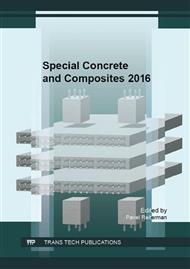[1]
D. Dixon, J. Hansen, L. Korkiala-Tantt, T. H. Karvonen, N. Marcos, U. Sievänen, Underground Disposal Facility Closure Design 2012, Working Report 2012-09, November 2013, on-line: https: /www. iaea. org/inis/collection/NCLCollectionStore/_Public/46/094/46094981. pdf.
Google Scholar
[2]
J. Vožech, Diplomová práce: Příprava a realizace bentonitového těsnění experiment EPSP, ČVUT, Praha (2015).
Google Scholar
[3]
M. White, S. Doudou, F. Neall, Deliverable n°D2. 1 Version n°1. 1 Design Bases and Criteria, DOPAS project FP7 EURATOM, (2014).
Google Scholar
[4]
Information on http: /www. surao. cz.
Google Scholar
[5]
Information on http: /www. trideniodpadu. cz/radioaktivni-odpad.
Google Scholar
[6]
D. Jozwiak-Niedzwiedzka, R. Jaskulski, M.A. Glinicki, Application of Image Analysis to Identify Quartz Grains in Heavy Aggregates Susceptible to ASR in Radiation Shielding Concrete, Materials 9(4) (2016), Article number 224.
DOI: 10.3390/ma9040224
Google Scholar
[7]
Green, K. M., Hoff, W. D., Caqrter, M. A., Wilson, M. A., Hyatt, J. P.: A high pressure permeameter for the measurement of liquid conductivity of porous construction materials. Review of Scientific Instruments, 1999, Vol. 70, p.3397 – 3401.
DOI: 10.1063/1.1149926
Google Scholar
[8]
P. Reiterman, M. Keppert, M. Čáchová, O. Holčapek, F. Vogel, K. Kolář, P. Konvalinka, Permeability and Basic Physical Properties of Concrete with Metakaolin Addition, Applied Mechanics and Materials 486 (2014) 313-318.
DOI: 10.4028/www.scientific.net/amm.486.313
Google Scholar
[9]
M. Dvořáková, I. Hanusová, J. Svoboda, M. Vencl, Experiment EPSP – Stavba zátky pro hlubinné úložiště radioaktivních odpadů v rámci evropského projektu DOPAS, Tunel, 23. ročník - č. 2/(2014).
Google Scholar
[10]
Centre of Experimental Geotechnics on the Faculty of Civil Engineering CTU, Bentonit, properties, on-line: www. ceg. fsv. cvut. cz.
Google Scholar
[11]
J. Koťátková, J. Zatloukal, P. Reiterman, J. Patera, Z. Hlaváč, P. Brabec, The Effect of Elevated Temperatures and Nuclear Radiation on the Properties of Biological Shielding Concrete, Key Engineering Materials 677 (2016) 8-16.
DOI: 10.4028/www.scientific.net/kem.677.8
Google Scholar
[12]
ČSN 73 1001: Foundation of structures. Subsoil under shallow foundations, (1987).
Google Scholar


